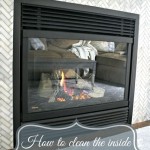Stone Fireplace Designs for Stoves: Integrating Form and Function
The integration of a stove within a stone fireplace presents a compelling combination of aesthetic appeal and practical heating solutions. Stone, a material revered for its durability and natural beauty, provides an excellent surround for wood-burning, pellet, or gas stoves. Designing a stone fireplace for a stove requires careful consideration of several factors, including the type of stove, the architectural style of the home, and the functional requirements of the heating system. This article explores various design elements and considerations for creating a stone fireplace that effectively houses and complements a stove.
The choice of stone significantly impacts the overall appearance and functionality of the fireplace. Natural stone, such as fieldstone, river rock, limestone, and slate, each offers unique textures and color variations. Manufactured or cultured stone provides a cost-effective alternative while replicating the look of natural stone. The selection process should prioritize not only the aesthetic match with the home's decor but also the stone's heat resistance and ability to withstand temperature fluctuations without cracking or deteriorating. Some types of stone are more porous than others, leading to potential staining or damage from soot and creosote. Therefore, sealing the stone surface can be a necessary step, depending on the type of stone chosen.
Building codes and safety regulations are paramount when constructing a stone fireplace designed for a stove. Proper clearances between the stove and combustible materials, such as wood framing, are crucial to prevent fire hazards. The fireplace hearth must be constructed of non-combustible materials and extend a specified distance in front of the stove to protect flooring from embers. Venting the stove requires a properly sized and installed chimney or flue system that meets local building codes and manufacturer specifications. Consulting with qualified professionals, such as masons, chimney sweeps, and heating specialists, is essential to ensure the safe and compliant installation of the stone fireplace and stove combination.
Key Point 1: Stone Selection and Aesthetic Integration
The selection of stone for a fireplace encasing a stove is a critical design decision, influencing both the aesthetic style and the functional performance of the installation. Different stone types possess distinct characteristics that can be leveraged to achieve specific design goals. Fieldstone, with its irregular shapes and earthy tones, lends a rustic, natural feel, ideal for homes with a country or farmhouse aesthetic. River rock, with its smooth, rounded stones, provides a more contemporary and refined look, suiting modern or transitional interiors.
Limestone, known for its creamy white or beige hues and subtle texture, offers a classic and elegant option that complements a variety of architectural styles. Slate, with its dark gray or black tones and layered appearance, creates a dramatic and sophisticated focal point. Manufactured stone provides a broader range of color and texture options, often at a lower cost than natural stone. It's important to consider the size and shape of the stones used in the fireplace design. Larger stones create a bolder and more imposing presence, while smaller stones offer a more intricate and detailed appearance.
The color palette of the stone should harmonize with the existing decor of the room. Neutral tones, such as grays, browns, and beiges, tend to be versatile and adaptable to various color schemes. Warmer tones, such as reds and oranges, create a cozy and inviting atmosphere. Cooler tones, such as blues and greens, offer a more calming and serene ambiance. Contrasting colors can be used to create visual interest and highlight specific features of the fireplace. For example, a dark stone surround can be paired with a lighter-colored hearth to create a striking focal point.
Beyond color, the texture of the stone plays a crucial role in the overall aesthetic impact. Rough, textured stones create a more rustic and tactile feel, while smooth, polished stones offer a more refined and elegant look. The choice of texture should be consistent with the architectural style of the home and the desired aesthetic effect. Proper lighting can enhance the beauty of the stone fireplace, highlighting its texture and color variations. Recessed lighting, sconces, and spotlights can be strategically positioned to create dramatic effects and accentuate the natural beauty of the stone.
Key Point 2: Functional Design Considerations for Stove Integration
Integrating a stove within a stone fireplace requires careful attention to functional design considerations to ensure optimal performance, safety, and ease of use. The size and shape of the stove must be compatible with the dimensions of the fireplace opening. Adequate clearance must be provided around the stove to allow for proper ventilation and prevent overheating. The hearth, the non-combustible surface in front of the stove, must be of sufficient size and thickness to protect the flooring from embers and radiant heat.
The design should incorporate features that facilitate easy access for loading fuel, cleaning ash, and performing maintenance on the stove. A convenient storage area for firewood or pellets can be integrated into the fireplace design, providing easy access to fuel and minimizing clutter. The chimney or flue system must be properly sized and installed to ensure adequate draft and prevent the buildup of creosote, a flammable byproduct of wood burning. Regular chimney inspections and cleaning are essential to maintain safe and efficient operation of the stove.
The design should optimize the heat output of the stove and distribute it effectively throughout the room. Convection currents can be enhanced by incorporating vents or openings in the fireplace surround that allow warm air to circulate freely. A blower fan can be installed to further improve heat distribution and increase the heating efficiency of the stove. The use of heat-resistant materials, such as firebrick or cast iron, in the construction of the fireplace can help to absorb and radiate heat, providing a more consistent and comfortable temperature.
Accessibility for maintenance and cleaning is crucial. A removable access panel or door can be incorporated into the design to allow for easy inspection and cleaning of the chimney or flue. The hearth should be durable and easy to clean, resistant to staining and scratching. Consider the placement of electrical outlets for powering blower fans or other accessories. Proper insulation is important to prevent heat loss and improve energy efficiency. The stone itself provides some insulation, but additional insulation may be necessary in certain areas, such as behind the fireplace or around the chimney.
Key Point 3: Safety and Code Compliance
Safety and code compliance are paramount considerations when designing and constructing a stone fireplace for a stove. Building codes and safety regulations dictate specific requirements for fire clearances, hearth size, chimney construction, and ventilation to prevent fire hazards and ensure the safe operation of the heating system. Local building codes vary, so it's essential to consult with local authorities and obtain the necessary permits before beginning construction.
Fire clearances are the minimum distances between the stove and combustible materials, such as wood framing, walls, and ceilings. These clearances are specified by the stove manufacturer and must be strictly adhered to. Failure to maintain proper clearances can result in overheating and potentially lead to a fire. The hearth must extend a specified distance in front of and to the sides of the stove to protect the flooring from embers and radiant heat. The size and thickness of the hearth are determined by the type of stove and the distance from the stove to the flooring.
The chimney or flue system must be constructed of non-combustible materials and properly sized to accommodate the stove's exhaust gases. The chimney must extend a sufficient height above the roof to ensure adequate draft and prevent backdrafting. Regular chimney inspections and cleaning are essential to prevent the buildup of creosote, which can ignite and cause a chimney fire. A chimney cap should be installed to prevent rain, snow, and debris from entering the chimney.
Ensure proper ventilation to provide adequate air for combustion and prevent the buildup of carbon monoxide, a deadly gas. Follow the stove manufacturer's instructions for ventilation requirements. Install carbon monoxide detectors in the home to provide an early warning of dangerous levels of carbon monoxide. Consider installing a fresh air intake to provide a direct source of outside air for combustion, especially in tightly sealed homes. Working closely with qualified professionals, such as masons, chimney sweeps, and heating specialists, is crucial to ensure the safe and compliant installation of the stone fireplace and stove combination. This collaborative approach guarantees that all aspects of the project meet the required safety standards and building codes, providing peace of mind and protecting occupants from potential hazards.
In addition, electrical safety should not be overlooked. If electrical components are integrated into the fireplace design, such as for blowers or lighting, ensure that all wiring is properly installed and grounded by a licensed electrician. Use only UL-listed components and follow all applicable electrical codes. Regularly inspect electrical connections for any signs of damage or wear.

Stone Fireplaces

65 Best Stone Fireplace Design Ideas

20 Ideas To Decorate Around A Wood Burning Stove

Stone Fireplace Ideas For Your Home Decostones

Natural Stacked Stone Veneer Fireplace Ideas

Gold Silver Donegal Quartzite Natural Stone With A Black Limestone Hearth Www Mcmonaglestone Com Wood Stove Fireplace Rock Fireplaces

Stone Veneer Fireplace Ideas That Will Warm Up Your Home Ply Gem

Natural Stacked Stone Veneer Fireplace Ideas

4 Natural Stacked Stone Fireplaces For Your Dream Design

40 Stone Fireplace Designs From Classic To Contemporary Spaces Decoist
Related Posts








